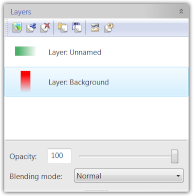Color blending modes
Blending of colors occurs whenever:
- Color gradient is generated.
- Semitransparent color is used.
- Layer opacity is less than 100%.
- A pixel is only partially covered.
In each scenario, there are 2 colors with opacity values and possibly a separate coverage factor.
Layer blending modes
Color blending are performed in the RGB color space. In most cases, the color channels are processed independently.

Layer blending mode is set in the lower part of the Layers panel using the Blending mode box.
Sample images: 

The following images demonstrate the result of a blending operation of the two sample images. Each contains a rectangle filled with a single color with opacity decreasing to the right or downwards.
 Normal blending mode
Normal blending mode
In this mode, the opacity/coverage value of the upper layer controls how much of the lower layer is visible. If the upper layer is opaque, nothing of the lower layer gets through. If the opacity of the upper layer is at X%, the final color is a sum of X% * upper_color + (100%-X%) * lower_color
Gamma correction is taken into account. Color values are linearized before the blending occurs.
 Multiply blending mode
Multiply blending mode
Photographers may know this blending mode as Burn.
Multiplication produces the same effect as would putting 2 slides into a slide projector.
In this mode, the resulting color is obtained by multiplying the two source colors. Since the color are in range 0..1, multiplying them lowers the values (0.5*0.5 = 0.25). This means the resulting color is darker.
 Screen blending mode
Screen blending mode
Photographers may know this blending mode as Dodge.
The screen mode is an inverse of the Multiply mode.
The resulting color is obtained by multiplying the inverted values of the source colors and the result is then again inverted. The resulting color is always brighter.
 Add blending mode
Add blending mode
The color values are simply added together. If the resulting value is bigger than the maximum, the maximum is used instead.
 Subtract blending mode
Subtract blending mode
The upper color is subtracted from the lower color. If the result is negative, 0 is used instead.
 Average blending mode
Average blending mode
As the name indicates, the average of the 2 colors: upper_color/2 + lower_color/2
 Difference blending mode
Difference blending mode
The two colors are subtracted from each other. If the result is negative, the sign is changed.
 Minimum (darken) blending mode
Minimum (darken) blending mode
The lower value of the two colors is used.
 Maximum (lighten) blending mode
Maximum (lighten) blending mode
The higher value of the two colors is used.
 Overlay blending mode
Overlay blending mode
A combination of screen and multiply modes. Increases contrast.
 Replace hue blending mode
Replace hue blending mode
The colors are converted to the HLS color space and then the Hue component is taken from the upper color and the rest from the lower color.
 Replace saturation blending mode
Replace saturation blending mode
The colors are converted to the HLS color space and then the Saturation component is taken from the upper color and the rest from the lower color.
 Replace brightness blending mode
Replace brightness blending mode
The colors are converted to the HLS color space and then the Brightness component is taken from the upper color and the rest from the lower color.
 Replace color blending mode
Replace color blending mode
The colors are converted to the HLS color space and then the Hue and Saturation components are taken from the upper color and the remaining one from the lower color.
 Silhouette blending mode
Silhouette blending mode
The opacity of upper layer is used to delete pixels from the lower layer.
Color blending for drawing tools
While using the drawing tools, users can choose one of 3 in-layer blending modes called "Paint over", "Replace" and "Paint under" with button in the toolbar (see Drawing modes).
 The Paint over blending mode is equal to the Normal blending mode in the layers.
The Paint over blending mode is equal to the Normal blending mode in the layers.
 The Paint under blending mode works similarly as the Paint over mode, but the colors are swapped.
The Paint under blending mode works similarly as the Paint over mode, but the colors are swapped.
 In the Replace mode, the old pixels are deleted before the new pixels are drawn. Replace mode only differs from the Paint over mode, if the used color is semitransparent.
In the Replace mode, the old pixels are deleted before the new pixels are drawn. Replace mode only differs from the Paint over mode, if the used color is semitransparent.